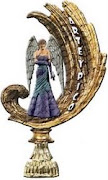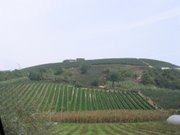We left Tottori for Osaka by train. This leg of our journey involved a difficult decision, because we were supposed to meet another family from Japan Cycling in Takashima, on the beautiful Lake Biwa north of Kyoto. The original plan was bike there from Kyoto, but we realized that we wouldn't have been able to do this and still have time to visit other cities we wanted to see.
(For American tourists there's a metric conversion pitfall one should be aware of: One converts the kilometers into miles, but then thinks to oneself that things are metric here, so the unit becomes kilometers again, e.g. 50km => 30 mi => 30 km--hence our surprise when Tetsuo told us that the ride from Kyoto would take the better part of a day!)
So in the end we declined Tetsuo's hospitality, hoping we hadn't been too rude, and sad because we knew how wonderful it would have been to spend another day with a Japanese family.
We knew from Tottori that the best way to get a cheap hotel in Japan was to find a tourist office and ask for a Japanese-style hotel, specifying precisely what you want to pay. (If you say, "We're looking for ¥10000 or less," you'll pay precisely ¥10000.) These offices are usually very close to train stations. The nice English-speaking officials at Osaka's told us to go south to an area with lots of cheap hotels. We biked south, and after crossing some huge intersections, we started really enjoying the city. Our ride was going to cross almost all the city, and we went through very different parts of it. Closer to the station there is the financial district, with elegant bridges, very tall buildings, and rose gardens along the river. Then we noticed some fancy districts, with expensive restaurants.
Here we stopped at an intersection to look at a map, and a young man stopped and asked us if we needed help. After he gave us directions (again, in English: it turned out that most Osakajin speak some English), we started chatting and asked him about his favorite local food. He asked if we had some time, and invited us inside of the restaurant he had come out of. He invited us to sit and gave us cold barley tea. While we drank and watched the sous-chefs work, he printed out maps for us, to show us where we could find Osaka's famous okonomiyaki and kushikatsu. Finally we asked him what his favorite restaurant in Osaka was. He answered, "Mine!" We hadn't realized he was the owner of the place we were in. He told us his restaurant made mostly beef dishes, of high quality. He warned us that it might be too expensive for us, most likely because he saw our dress and transportation, and he knew we were headed toward cheap hotels. Unfortunately, when we stopped by the restaurant later that night, we saw it was completely full, and thought our shorts and T-shirts weren't exactly appropriate for such a place. Nevertheless, we were impressed that he had been so helpful to people who weren't even potential customers.
We kept biking south, and crossed more and more very lively districts. Lots of people were walking and biking everywhere. The bikes especially seemed to follow no rules, going from sidewalk to road, with or against traffic: 
The cheap hotel area was, as expected, a poor one. An interesting detail: the first hotel we asked in told us that they allowed only Japanese people! Perhaps they were tired of westerners, not knowing which shoes to use to enter the different rooms, and leaving crumbs on tatami mats, etc. Anyway, we did find a cheap Japanese-style hotel to stay at (¥6000), where the friendly desk clerk quizzed me about Italian football.
The area close by was a maze of small streets filled with places selling street food and (mostly) old men playing shogi. The most popular food sold there was kushikatsu, exactly what we had been told to try. We entered one of the stores, where a team of young cooks was inviting us in, whereupon we were simultaneously greeted by the entire team. It was very crowded, with people (mostly quite young too) seated all around the bar:

Osaka became more and more lively as the night went on. Large crowds were strolling along streets that became more and more bright, for all the lights.
And stands on the streets were selling every kind of food, from grilled or fried meat to this delicious red bean filled, fish shaped snack.
I have visited many big cities around the world, from Paris to London to New York, but I had never seen such a large area completely filled with people out and enjoying the night. It was exciting and dazing at the same time. Some areas were even more bright and confusing, inside long galleries with lines and lines of stores:
Okonomiyaki is a savory pancake made with eggy batter and cabbage, topped with pork, and anything else you would want in it. It's served on a grill (sometimes they let you make it yourself at the table), and seasoned with mayonnaise, okonomi sauce (ingredients: tomato, apple, carrot, sugar vinegar, oyster flavor), and katsuobushi flakes to taste. Here is our okonomiyaki, topped with pork, pickled ume and shiso (a relative of basil, so common in Japan that there is now a shiso Pepsi). The katsuobushi flakes dance in the steam:
As you can guess, okonomyiaki is quite good and filling.
Back to the more lively area, we listened to some jazz:
We completed our evening with a stroll along this peaceful canal.
Here we found a hole-in-the-wall place making crepes. While ordering, the chef asked me where I was from, and at my reply, said crepes came originally from Italy. I said, "Wasn't it France?" "No, no! That's what you might think," he said, "but in fact they were first made in Italy." Later on, I thought he may have been rightfully referring to crespelle, the lesser known, Italian crepes, which are usually savory and baked with a white sauce. His crepe turned out to be really good, as thin as the ones in Paris. Sugoi! To prepare to serve crepes from this hole in the wall, the chef/owner not only learned the right way to make them, but had also studied their history!
The day after we started our final bike ride towards Kyoto. Before leaving Osaka, we stopped by the castle, which was on our way. The castle is surrounded by two impressive sets of walls. This is the external one.
It's a very elegant building, constructed between 1583 and 1598.
We didn't go inside, because we were hoping to get to Kyoto in the early afternoon. We chose to bike along the Yodo river, which connects Osaka to Kyoto. We guessed that we would find a bike path, and in fact, after getting lost a few times and fighting though vendors setting up for a festival, we found a wide bike path that followed the river almost all the way.
Again, we misunderstood the distance on the map, and when we saw this nice sight on the east side of the river we thought that the skyscrapers were the sign of the beginning of Kyoto suburbs:
We kept pleasantly biking along the river. Towards the end, unfortunately, we lost the path and had to bike along 171, possibly the worst road for biking in the whole trip. Looking at google maps, it seems like we may have had to cross the river to avoid this part. We found the path again closer to Kyoto, and we arrived in the city around 4:30. We had a meeting for dinner at six, so we started looking for a hotel. However, crossing the city took us much longer than we thought, and we had just enough time to stop by a public restroom and wash off the dirt and bike grease before meeting our friend.
[To be continued!]
Wednesday, August 12, 2009
Cicloturismo in Giappone III: da Osaka a Kyoto
Posted by
chemcookit
at
12:26 AM
![]()
Labels: cyclotouring, trip (Asia)
Subscribe to:
Post Comments (Atom)












No comments:
Post a Comment